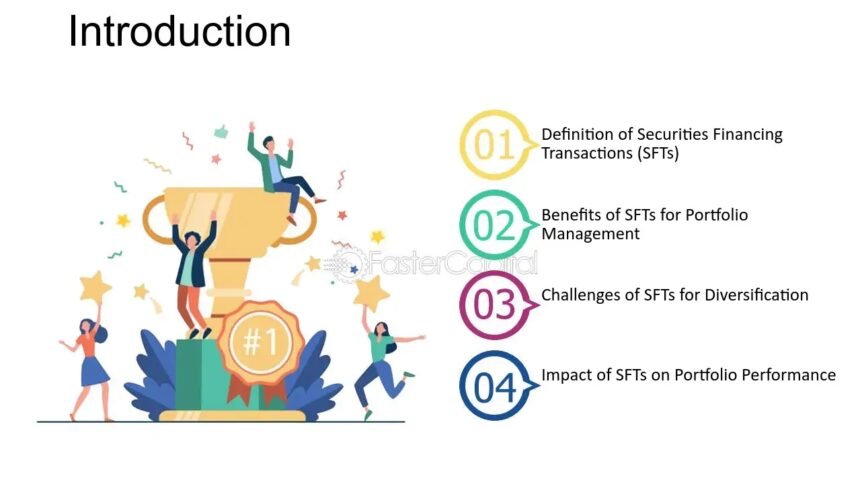Securities Financing Transactions (SFTs) play a vital role in the financial markets, particularly in facilitating liquidity, leveraging positions, and enhancing market efficiency. These transactions are a staple in institutional finance, allowing the temporary transfer of securities between parties under an agreement. For traders and financial institutions, understanding how SFTs work is crucial to managing risk, optimizing portfolios, and navigating market fluctuations. In this blog, we will delve into the core mechanics of securities financing transactions, their key components, benefits, and the regulatory landscape surrounding them. By examining these factors, you will gain valuable insights into the strategic significance of SFTs in today’s complex financial markets.
What Are Securities Financing Transactions?
Securities Financing Transactions are arrangements in which securities are temporarily transferred from one party to another, typically as collateral for loans or other financing purposes. In simple terms, an SFT involves a borrower using securities as collateral for receiving cash or other assets from a lender. The borrower agrees to return equivalent securities at a later date, usually with an agreed-upon fee. The most common types of SFTs are repurchase agreements (repos), securities lending, and margin lending.
The purpose of SFTs can vary, but the primary motive is to obtain short-term funding or improve liquidity. For financial institutions, SFTs offer a way to raise capital without having to sell assets outright. Meanwhile, investors often use SFTs to enhance their return on securities by lending them out to other market participants for a fee.
Types of Securities Financing Transactions
There are several types of securities financing transactions, each serving different purposes. The main types include:
Repurchase Agreements (Repos)
A repo involves the sale of securities with an agreement to repurchase them at a later date. It is essentially a short-term loan where securities are used as collateral. Repos are frequently used by central banks and financial institutions to manage liquidity and funding needs.
Securities Lending
Securities lending occurs when an owner of securities temporarily lends them to another party in exchange for collateral. The borrower of the securities typically uses them for short selling, hedging, or other trading strategies. The lender receives collateral to mitigate risk and a lending fee as compensation.
Margin Lending
Margin lending occurs when an investor borrows money from a financial institution to purchase securities. The purchased securities act as collateral, and the investor is required to maintain a minimum margin. This form of financing enables investors to leverage their positions but introduces the risk of margin calls if the value of the securities falls.
The Role of Securities Financing in Financial Markets
Securities financing transactions function as an essential mechanism for liquidity provision in financial markets. They provide market participants, including institutional buyers, hedge funds, and banks, with the ability to access funds while retaining ownership of their assets. By engaging in SFTs, institutions can enhance their capital efficiency, as they do not need to liquidate securities to obtain cash.
Moreover, SFTs facilitate price discovery and can help smooth out market volatility by enabling investors to leverage positions and meet margin calls without selling assets in the open market. In this regard, SFTs act as a buffer to market instability, making them a crucial tool for market participants during periods of financial strain.
Risks Associated with Securities Financing Transactions
While SFTs offer numerous benefits, they also come with inherent risks. These risks primarily arise from the temporary nature of the transactions, the reliance on collateral, and the possibility of counterparty default.
Counterparty Risk
This is the risk that the other party in the transaction may fail to meet its obligations, such as failing to return borrowed securities or defaulting on the loan. This risk is particularly concerning in uncollateralized or poorly collateralized loans, where the lender may suffer losses.
Liquidity Risk
Securities financing transactions can also expose participants to liquidity risk, especially if they are unable to liquidate collateral in a timely manner or if there is a sudden drop in the value of the collateral.
Collateral Risk
Since securities are used as collateral in many SFTs, fluctuations in the value of the collateral pose a significant risk to the lender. Collateral value may fall below the agreed threshold, leading to a situation where the collateral no longer sufficiently covers the value of the loan.
Regulatory Risk
As the financial landscape evolves, new regulations may impact how SFTs are conducted. For example, regulations such as the European Union’s Securities Financing Transactions Regulation (SFTR) and Basel III are designed to increase transparency and reduce risks associated with SFTs. Financial institutions must remain vigilant to ensure compliance with such regulations.
Regulatory Framework for Securities Financing Transactions
The regulatory landscape surrounding securities financing transactions has evolved significantly in recent years. Following the 2008 global financial crisis, regulatory bodies across the world sought to increase transparency in SFT markets to mitigate systemic risks. One notable regulatory development is the introduction of the Securities Financing Transactions Regulation (SFTR) by the European Union. The SFTR aims to enhance the transparency of SFTs by requiring financial institutions to report these transactions to trade repositories.
Additionally, the Basel III framework introduced more stringent capital and liquidity requirements for banks involved in SFTs, aiming to strengthen the resilience of financial institutions. These regulatory measures aim to mitigate systemic risk, promote transparency, and ensure that SFTs are conducted in a safe and sound manner.
Expert Opinion on the Future of Securities Financing
John Smith, a financial analyst at a leading investment firm, states, “As financial markets continue to evolve, the role of securities financing transactions in providing liquidity and capital efficiency will only grow. However, investors and financial institutions need to be mindful of the risks involved and ensure that they are adequately managing counterparty, collateral, and regulatory risks.”
This expert insight underscores the importance of understanding the complexities of SFTs, particularly as the regulatory landscape tightens and financial institutions continue to navigate increasingly volatile markets.
The Impact of Technology on Securities Financing Transactions
In recent years, advancements in technology have significantly impacted the securities financing market. The advent of blockchain and distributed ledger technology (DLT) is poised to revolutionize the way SFTs are conducted. These technologies promise to enhance transparency, reduce counterparty risk, and streamline settlement processes by creating immutable and real-time transaction records.
Additionally, the use of machine learning and artificial intelligence in risk management is becoming more prevalent. Financial institutions are leveraging these technologies to improve their ability to assess creditworthiness, evaluate collateral, and monitor market trends more efficiently.
Conclusion
Securities financing transactions are an essential component of the global financial system, offering critical benefits to investors, banks, and other market participants. By providing liquidity, enhancing capital efficiency, and improving market stability, SFTs contribute to the smooth functioning of financial markets. However, as with any financial instrument, they come with risks that must be carefully managed.
Regulations aimed at increasing transparency and reducing systemic risk, such as SFTR and Basel III, play an important role in mitigating the risks associated with these transactions. Furthermore, the integration of emerging technologies is set to transform the securities financing market, making it more efficient, transparent, and secure.
For investors and financial institutions, understanding the mechanics, risks, and regulatory considerations surrounding securities financing transactions is crucial for leveraging their potential while maintaining a robust risk management strategy. As the financial markets continue to evolve, SFTs will remain a cornerstone of modern financial strategy, driving liquidity, market efficiency, and capital management.






